Mar 11, 2010
Loony Erlich is the ideal spokesman for the AGW movement
By Paul Erlich
The question of the day is how Paul Erlich, doomsayer deluxe, could still have a job never mind pen an editorial for Nature. In today’s world it doesn’t matter if you were ever right only that you are in agreement in Dick Lindzen’s words with “the sensibilities of the east and west coast” elitists. See this story on some of his former prognostications about the future of humanity including only 20 million people would still be alive in the U.S by 2000 because of pesticides. Recently he led the attack on skeptics in the New York Times “Most of our colleagues don’t seem to grasp that we’re not in a gentlepersons’ debate, we’re in a street fight against well-funded, merciless enemies who play by entirely different rules,” Paul R. Ehrlich, a Stanford University researcher, said in one of the e-mails.
Ehrlich started his academic career as an entomologist, an expert on Lepidoptera - butterflies. Following are excerpts from that Nature editorial.
The integrity of climate research has taken a very public battering in recent months. Scientists must now emphasize the science, while acknowledging that they are in a street fight.
Climate scientists are on the defensive, knocked off balance by a re-energized community of global-warming deniers who, by dominating the media agenda, are sowing doubts about the fundamental science. Most researchers find themselves completely out of their league in this kind of battle because it’s only superficially about the science. The real goal is to stoke the angry fires of talk radio, cable news, the blogosphere and the like, all of which feed off of contrarian story lines and seldom make the time to assess facts and weigh evidence. Civility, honesty, fact and perspective are irrelevant.
Worse, the onslaught seems to be working: some polls in the United States and abroad suggest that it is eroding public confidence in climate science at a time when the fundamental understanding of the climate system, although far from complete, is stronger than ever. Ecologist Paul Ehrlich at Stanford University in California says that his climate colleagues are at a loss about how to counter the attacks. “Everyone is scared shitless, but they don’t know what to do,” he says.
Scientists must not be so naive as to assume that the data speak for themselves. Researchers should not despair. For all the public’s confusion about climate science, polls consistently show that people trust scientists more than almost anybody else to give honest advice. Yes, scientists’ reputations have taken a hit thanks to headlines about the leaked climate e-mails at the University of East Anglia (UEA), UK, and an acknowledged mistake about the retreat of Himalayan glaciers in a recent report from the Intergovernmental Panel on Climate Change (IPCC). But these wounds are not necessarily fatal.
To make sure they are not, scientists must acknowledge that they are in a street fight, and that their relationship with the media really matters. Anything strategic that can be done on that front would be useful, be it media training for scientists or building links with credible public-relations firms. In this light, there are lessons to be learned from the current spate of controversies. For example, the IPCC error was originally caught by scientists, not sceptics. Had it been promptly corrected and openly explained to the media, in full context with the underlying science, the story would have lasted days, not weeks. The IPCC must establish a formal process for rapidly investigating and, when necessary, correcting such errors.
The unguarded exchanges in the UEA e-mails speak for themselves. Although the scientific process seems to have worked as it should have in the end, the e-mails do raise concerns about scientific behaviour and must be fully investigated. Public trust in scientists is based not just on their competence, but also on their perceived objectivity and openness. Researchers would be wise to remember this at all times, even when casually e-mailing colleagues.
US scientists recently learned this lesson yet again when a private e-mail discussion between leading climate researchers on how to deal with sceptics went live on conservative websites, leading to charges that the scientific elite was conspiring to silence climate sceptics (see page 149). The discussion was spurred by a report last month from Senator James Inhofe (Republican, Oklahoma), the leading climate sceptic in the US Congress, who labelled several respected climate scientists as potential criminals - nonsense that was hardly a surprise considering the source. Some scientists have responded by calling for a unified public rebuttal to Inhofe, and they have a point. As a member of the minority party, Inhofe is powerless for now, but that may one day change. In the meantime, Inhofe’s report is only as effective as the attention it receives, which is why scientists need to be careful about how they engage such critics.
The core science supporting anthropogenic global warming has not changed. This needs to be stated again and again, in as many contexts as possible. Scientists must not be so naive as to assume that the data speak for themselves. Nor should governments. Scientific agencies in the United States, Europe and beyond have been oddly silent over the recent controversies. In testimony on Capitol Hill last month, the head of the US Environmental Protection Agency, Lisa Jackson, offered at best a weak defence of the science while seeming to distance her agency’s deliberations from a tarnished IPCC. Officials of her stature should be ready to defend scientists where necessary, and at all times give a credible explanation of the science.
These challenges are not new, and they won’t go away any time soon. Even before the present controversies, climate legislation had hit a wall in the US Senate, where the poorly informed public debate often leaves one wondering whether science has any role at all. The IPCC’s fourth assessment report had huge influence leading up to the climate conference in Copenhagen last year, but it was always clear that policy-makers were reluctant to commit to serious reductions in greenhouse-gas emissions. Scientists can’t do much about that, but they can and must continue to inform policy-makers about the underlying science and the potential consequences of policy decisions - while making sure they are not bested in the court of public opinion.
Mar 05, 2010
Bill Gray on Kerry Emanuel’s Boston Globe Op/Ed piece titled “Climate Changes Are Proven Fact”
By Bill Gray, Professor Emeritus, Colorado State University
This piece has many inaccuracies, and in my view, is not a positive contribution to the global warming debate for the reasons I present in my rebuttal of various Emanuel statements.
Emanuel “...compelling strands of scientific evidence that have led almost all climate scientists to conclude that mankind is altering climate in potentially dangerous ways.”
Gray: A high percentage of meteorologists and/or climate scientists do not agree that the climate changes we have seen are mostly man-made. Thousands of us think that the larger part of the climate changes we have observed over the last century are of natural origin. I believe that most of the changes that have been observed are due to multi-decadal and multi-century changes in deep global ocean currents. Such changes have yet to be properly incorporated into the global models or into most climate modeler’s physical reasoning processes. Over 31 thousand American scientists have recently signed a petition advising the US not to sign any fossil fuel reduction treaty.
Many scientists believe that a slightly warmer CO2 gas induced world, would be, in general, more beneficial for humanity. The small changes in climate we have seen so far and the changes we will likely see in the next number of decades are not potentially dangerous. It has been noted that vegetation growth is enhanced by higher CO2 levels.
Emanuel “...the surface temperature of the Earth is roughly 60 F higher than it would otherwise be thanks to a few greenhouse gasses that collectively make up only about 3 percent of the mass of our atmosphere.”
Gray: The globe’s greenhouse gas induced higher temperatures are due almost exclusively to water vapor (the overwelling greenhouse gas) not much at all due to CO2 and methane. It is the variation of atmospheric water vapor (particularly in the upper troposphere) that is of dominant importance to the greenhouse gas warming question. It is likely that increases in CO2 and other minor greenhouse gases will lead to small reductions in upper tropospheric water vapor which will bring about greater loss of infrared radiation energy flux to space. Increases in CO2 and lesser greenhouse gases should (due to their influence on upper level water vapor) lead to little global temperature increase. Such conditions appear to be presently occurring. During the last decade and a half when CO2 amounts have risen there has been an increased (not decreased) infrared radiation flux to space. Little or no global warming has occurred in the last decade.
Emanuel “...in the absence of any feedbacks except for temperature itself, doubling carbon dioxide would increase the global average surface temperature by about 1.8 F.”
Gray: You can’t at the outset eliminate water vapor and cloud feedback and consider only temperature feedback and expect to have a realistic explanation of CO2’s future influence on global temperature. Water vapor and cloud feedback changes can negate most or all the lesser greenhouse gas influences on global temperature.
Emanuel “...the rate of rise of surface temperature is consistent with predictions of human-caused global warming that date back to the 19th century and is larger than any natural change we have been able to discern for at least the past 1,000 years.”
Gray: this is pure ‘off-the-wall’ assertion that the global warmers want to believe in because they do not want to consider other causes of climate change which would negate their human-induced warming hypothesis. The global warming community has yet to come to grips with the powerful potential climate altering influences of multi-decadal and multi-century changes in the globe’s deep ocean circulations. The Medieval warm period and the early Holocene warm period are believed to have been warmer than today’s temperatures. Some natural processes brought about these changes. Why could these same natural processes not be acting today?
Emanuel “...current models predict that a doubling of carbon dioxide should result in global mean temperature increases of anywhere from 2.5 to 7.5 F.”
Gray: All the global General Circulation Models (GCMs) which predict future global temperature change for a doubling of CO2 are badly flawed. They do not realistically handle the changes in upper tropospheric water vapor and cloudiness. They give unrealistically high upper-tropospheric moisture and temperature condition for CO2 doubling. Model global warming estimates for a doubling of CO2 are thought by thousands of us to be many times larger than what will likely occur. The GCMs are not yet simulating the fundamental influence of the multi-decadal and multi-century scale variations of the ocean’s deep circulation patterns.
It should be noted that the GCMs have failed to account for the weak global cooling over the last decade. It is also important to note that the GCM groups do not make official shorter range global temperature forecasts of 1 to 10 years which could accurately be verified. If they won’t do this why should we believe their forecasts at 50-100 years? Any experienced meteorologist or climate scientist who would actually believe a long range climate model should really have their head examined. They are living in a dream world.
Emanuel “...models...represent our best efforts to objectively predict climate; everything else is mere opinion and speculation.”
Gray: As discussed above, the global GCM climate models are likely our worst (not best) guide to the future. The physics and numerical coding within the global climate models will never be able to replicate the overly complex global atmosphere-ocean environment and its continuing changes. Especially so with the need for integrations over hundreds of thousands of time steps. Increases in future measurement detail accuracy and future increases in computer power will likely never be sufficient to make skillful long range climate modeling a possibility. Climate prediction skill should be considered and will likely continue to be about as reliable as long range stock prediction.
Our only guide to the future climate rests with the study of past observations of the globe together with judicious physical reasoning of the primary process which in the past have influenced climate change.
Emanuel “That they are uncertain cuts both ways; things might not turn out as badly as the models now suggest, but with equal probability, they could turn out worse.’
Gray: Ridiculous. The global models have grossly errored on the side of too much global warming though their assumptions of unrealistic positive water vapor feed-back loop and lack of consideration of deep ocean currents. There is absolutely no way the models could have underplayed the role of human-induced CO2 increases on global warming.
Emanuel “We do not have the luxury of waiting for scientific certainty, which will never come, nor does it do anyone any good to assassinate science, the messenger.”
Gray: Living in an academic ‘ivory tower’ relieves Emanuel of having to face up to the hard economic and social realities of reducing fossil fuel usage. Following Emanuel’s logic we should move to implement the Cap-and-Trade bill presently before Congress, agree to international standards to implement fossil fuel restrictions and follow UN-global government dictates. I wonder if Emanuel has factored in the ensuing much higher costs of renewable energy and the resulting significant lowering of the global population’s standard of living, which large fossil fuel reductions would bring. I wonder if Emanuel realizes the effects these changes would have on the increased poverty and starvation within 3rd world countries. And has he considered how little the environment would really improve if such human sacrifices for nature were made?
We should all feel an obligation to assassinate ‘faulty’ science wherever we see it, including the blind belief (without evidence except the faulty models) that humans are largely responsible for climate change.
Emanuel “We might begin by mustering the courage to confront the problem of climate change in an honest and open way.”
Gray: Emanuel needs to make a better effort to follow his own advice. His Op/Ed piece is one-sided and is less than an honest and fair representation of the global warming controversy.
Read both Emanuel’s op ed and Gray’s response here.
------------------
Climate science survives scandal
Big Pond News
Climate science is alive and well despite the scandal of leaked emails in Britain and ‘glitches’ in a report by the UN climate change panel, top scientists say.
‘There’s consensus that action is justified, indeed imperative to reduce the problem of a really serious long-term global effect on the climate,’ said Lord Martin Rees, president of the British academy of science, the Royal Society.
‘My personal take is the key bit of evidence is the rise in CO2 concentration plus simple physics. If we had no data other than that, that would be enough,’ Rees told reporters on Friday at the annual meeting of the American Association for the Advancement of Science.
Climate change sceptics seized on a leak of thousands of emails and other documents from researchers at the Climatic Research Unit at the University of East Anglia in Britain, which appeared to show scientists saying global warming was not as serious as previously thought. That scandal, dubbed Climategate, came just weeks before UN talks on climate change in Copenhagen in December.
Several weeks after the talks, another scandal rocked the world of climate science, when the UN’s Intergovernmental Panel on Climate Change (IPCC) was accused of basing a report about ice disappearing from the world’s mountain peaks on a student essay and an article in a mountaineering magazine.
But scientists weren’t out for the count; they just can’t, ethically, ‘go into the gutter’ the way the media have in attacking the science world over the leaks, said Jerry North of Texas AM University. ‘It’s easy vilify scientists but scientists cannot go into the gutter and turn the attacks the other way. ‘But the climate science paradigm is in fact quite healthy. We just have a lot of challenges about how we communicate,’ said North.
Scientists may be good at crunching numbers and data, but they’re bad at doing their own public relations, said Ralph Cicerone, president of the National Academy of Sciences. ‘There are a lot of smart people working on climate change right now, but we’re not doing a good job of translating what we’re learning to the public,’ said Cicerone.
‘Instead when we have a major snowstorm on the east coast of the US, jokes are proliferating about how wrong all this global warming stuff was. And yet you turn on your television and look at the winter Olympics in Canada and you find no snow...’
Icecap note: The Rees and Cicerone’s and North’s are in denial. They are exampls of what is wrong with science today. They have damaged their credibility and that of their once great societies and universities by their words and actions. The physics and science they claim is so well established is not there and the entire movement, driven by those with big money and other agendas is built on the foundation of an unproven hypothosis.
Mar 03, 2010
Coldest winter for more than 30 years… but Met Office defends its long range forecast
By Fiona Macrae, Daily Mail Online
Perhaps someone should ask workers at the Met Office to take a rain check on their optimism. After predicting just a 20 per cent chance of a colder than average winter, they were left embarrassed again when official figures revealed it was the coldest for more than 30 years. Temperatures in December, January and February struggled to stay above zero, with the UK’s average a chilly 1.5C (35F), making it the deepest freeze since 1978-79.

Mothers tow children on their sledges in Hampshire, in January. The Met Office has confirmed that 2009/10 winter was the coldest since 1978/79
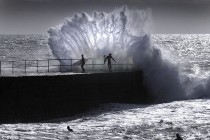
Two surfers negotiate a freak 30ft wave in Porthleven, Cornwall
And in Scotland and Northern Ireland it was the coldest winter since 1962-63. Altnaharra in northern Scotland recorded the lowest temperature of -22C (-8F) on the morning of January 8. The previous day brought England’s lows, of -17.6C (0.32F) in Woodford on the edge of Manchester and -17.7C (0.14F) in Benson, Oxfordshire.
The figures - released yesterday to mark the first day of spring - sharply contrast with the forecast of the Met Office last autumn. Its ‘long-range’ predictions for the winter, said there was a 50 per cent chance of it being mild and just a 20 per cent risk of it being colder than the average temperature of 3.7C (39F). In mid-December the forecast was revised to say there was a 45 per cent chance that January and February would be colder than average.
In January, as Britain was warned to expect a ‘windchill Saturday’, with blasts of wind forcing daytime temperatures as low as -10C, a senior Met Office official admitted it should have done better.

Crocuses in bloom on the first day of March in Hyde Park, London instead of Daffodils, a month behind schedule.
Asked on BBC TV: ‘Why didn’t you see this coming?’, Keith Groves replied: ‘I’m disappointed that our seasonal forecasts didn’t give a prediction or stronger probability of a colder winter.’ It was also forced to defend its long-range forecasting last autumn, when the much-feted ‘barbecue summer’ proved to be a washout.
And last night the Met Office was on the back foot again. Spokesman John Hammond said: ‘You have got to bear in mind that it is a relatively new forecast. Only 20 years ago you would be looking at a one or two-day forecast and questioning its accuracy. Now we take those for granted. ‘Given our geographical position we are very much at a crossroads of weather patterns and that makes it more challenging, but that is part of the game. We will continue to do the research and make sure [forecasts] improve in the future.’
Even the flowers are testament to the chill. While daffodils would usually have been in full bloom at yesterday’s St David’s Day celebrations, the classic sign of spring has been delayed.

Daffodils in Ewenny, Bridgend did not grow in time for St David’s Day yesterday due to consistent freezing temperatures
See post and more here. See real reason for the winter cold here.
Baltic Sea ice traps passenger and cargo ships
BBC News
A number of ships, including ferries with thousands of passengers on board, have become stuck in ice in the Baltic Sea, officials say. The vessels are grounded in the waters between Stockholm and the Aland Islands, Radio Sweden reports.
Many of the vessels are not likely to be freed for hours, Swedish maritime authorities were quoted as saying by the AFP news agency. It is reportedly the worst Baltic freeze for 15 years.
Both Sweden and Finland have deployed ice breakers in the area to help the stranded vessels. “The ice wouldn’t usually be a problem for the merchant ships, the problem now is that it’s very windy, about 20 metres per second,” Jonas Lindvall, controller of the ice breaking unit at the Swedish maritime authorities, told Radio Sweden. “That means that the ice is moving rapidly, there are lots of ridges with ice that’s making it problematic for the ships, so they need help from the ice breakers,” the controller said.
Four Viking Line ferries - which regularly shuttle thousands of passengers between Finland and Sweden - are among the vessels stuck. Unconfirmed reports say the ferries collided with each other when they tried to manoeuvre in packs of ice. See post here.
Feb 25, 2010
Most Negative AO Index Winter since 1950
By Joseph D’Aleo
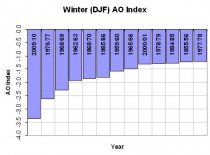
Enlarged here.
This was the result of major stratospheric warming for most of the winter, related to solar and high latitude volcanoes.
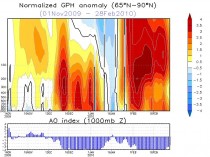
Look how well AO correlated with Cleveland temperatures since November (analysis by Scott Sabol, FOX8, Cleveland) here.
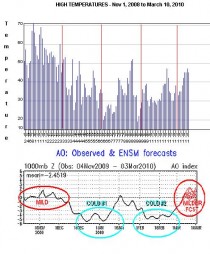
Here was the result in the US:
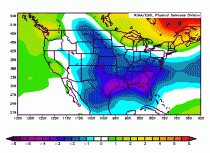
and here also for Eurasia

Here was the effect on Northern Hemispheric snowcover. 2010 in week 7 had the greatest snowcover since records began in the late 1960s, ahead of week 7 in 1978, another top ten most negative AO winters.
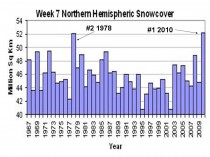
See an analysis of the factors here and another here. More to come on the results this amazing winter this week.
--------------------
The Warning in the Stars
By David Archibald
If climate is not a random walk, then we can predict climate if we understand what drives it. The energy that stops the Earth from looking like Pluto comes from the Sun, and the level and type of that energy does change. So the Sun is a good place to start if we want to be able to predict climate. To put that into context, let’s look at what the Sun has done recently. This is a figure from “Century to millenial-scale temperature variations for the last two thousand years indicated from glacial geologic records of Southern Alaska” G.C.Wiles, D.J.Barclay, P.E.Calkin and T.V.Lowell 2007:

The red line is the C14 production rate, inverted. C14 production is inversely related to solar activity, so we see more C14 production during solar minima. The black line is the percentage of ice-rafted debris in seabed cores of the North Atlantic, also plotted inversely. The higher the black line, the warmer the North Atlantic was. The grey vertical stripes are solar minima. As the authors say, “Previous analyses of the glacial record showed a 200- year rhythm to glacial activity in Alaska and its possible link to the de Vries 208-year solar (Wiles et al., 2004). Similarly, high-resolution analyses of lake sediments in southwestern Alaska suggests that century-scale shifts in Holocene climate were modulated by solar activity (Hu et al., 2003). It seems that the only period in the last two thousand years that missed a de Vries cycle cooling was the Medieval Warm Period.”
The same periodicity over the last 1,000 years is also evident in this graphic of the advance/retreat of the Great Aletsch Glacier in Switzerland (below enlarged here):
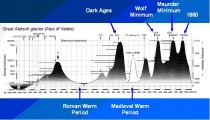
The solar control over climate is also shown in this graphic of Be10 in the Dye 3 ice core from central Greenland (below enlarged here)::
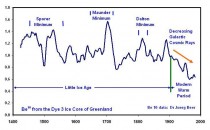
The modern retreat of the world’s glaciers, which started in 1860, correlates with a decrease in Be10, indicating a more active Sun that is pushing galactic cosmic rays out from the inner planets of the solar system.
The above graphs show a correlation between solar activity and climate in the broad, but we can achieve much finer detail, as shown in this graphic from a 1996 paper by Butler and Johnson (below enlarged here)::
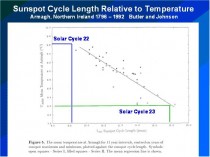
Butler and Johnson applied Friis-Christensen and Lassen theory to one temperature record - the three hundred years of data from Armagh in Northern Ireland. There isn’t much scatter around their line of best fit, so it can be used as a fairly accurate predictive tool. The Solar Cycle 22/23 transition happened in the year of that paper’s publication, so I have added the lengths of Solar Cycles 22 and 23 to the figure to update it. The result is a prediction that the average annual temperature at Armagh over Solar Cycle 24 will be 1.4C cooler than over Solar Cycle 23. This is twice the assumed temperature rise of the 20th Century of 0.7 C, but in the opposite direction.
To sum up, let’s paraphrase Dante: The darkest recesses of Hell are reserved for those who deny the solar control of climate. See PDF.
------------------------------
Wind power is a complete disaster
By Michael J. Trebilcock, Financial Post
There is no evidence that industrial wind power is likely to have a significant impact on carbon emissions. The European experience is instructive. Denmark, the world’s most wind-intensive nation, with more than 6,000 turbines generating 19% of its electricity, has yet to close a single fossil-fuel plant. It requires 50% more coal-generated electricity to cover wind power’s unpredictability, and pollution and carbon dioxide emissions have risen (by 36% in 2006 alone).
Flemming Nissen, the head of development at West Danish generating company ELSAM (one of Denmark’s largest energy utilities) tells us that “wind turbines do not reduce carbon dioxide emissions.” The German experience is no different. Der Spiegel reports that “Germany’s CO2 emissions haven’t been reduced by even a single gram,” and additional coal- and gas-fired plants have been constructed to ensure reliable delivery.
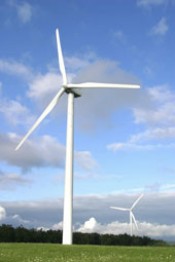
Indeed, recent academic research shows that wind power may actually increase greenhouse gas emissions in some cases, depending on the carbon-intensity of back-up generation required because of its intermittent character. On the negative side of the environmental ledger are adverse impacts of industrial wind turbines on birdlife and other forms of wildlife, farm animals, wetlands and viewsheds.
Industrial wind power is not a viable economic alternative to other energy conservation options. Again, the Danish experience is instructive. Its electricity generation costs are the highest in Europe (15 cents/kwh compared to Ontario’s current rate of about 6 cents). Niels Gram of the Danish Federation of Industries says, “windmills are a mistake and economically make no sense.” Aase Madsen , the Chair of Energy Policy in the Danish Parliament, calls it “a terribly expensive disaster.”
The U.S. Energy Information Administration reported in 2008, on a dollar per MWh basis, the U.S. government subsidizes wind at $23.34 - compared to reliable energy sources: natural gas at 25 cents; coal at 44 cents; hydro at 67 cents; and nuclear at $1.59, leading to what some U.S. commentators call “a huge corporate welfare feeding frenzy.” The Wall Street Journal advises that “wind generation is the prime example of what can go wrong when the government decides to pick winners.”
The Economist magazine notes in a recent editorial, “Wasting Money on Climate Change,” that each tonne of emissions avoided due to subsidies to renewable energy such as wind power would cost somewhere between $69 and $137, whereas under a cap-and-trade scheme the price would be less than $15.
Either a carbon tax or a cap-and-trade system creates incentives for consumers and producers on a myriad of margins to reduce energy use and emissions that, as these numbers show, completely overwhelm subsidies to renewables in terms of cost effectiveness.
The Ontario Power Authority advises that wind producers will be paid 13.5 cents/kwh (more than twice what consumers are currently paying), even without accounting for the additional costs of interconnection, transmission and back-up generation. As the European experience confirms, this will inevitably lead to a dramatic increase in electricity costs with consequent detrimental effects on business and employment. From this perspective, the government’s promise of 55,000 new jobs is a cruel delusion.
A recent detailed analysis (focusing mainly on Spain) finds that for every job created by state-funded support of renewables, particularly wind energy, 2.2 jobs are lost. Each wind industry job created cost almost $2-million in subsidies. Why will the Ontario experience be different?
In debates over climate change, and in particular subsidies to renewable energy, there are two kinds of green. First there are some environmental greens who view the problem as so urgent that all measures that may have some impact on greenhouse gas emissions, whatever their cost or their impact on the economy and employment, should be undertaken immediately.
Then there are the fiscal greens, who, being cool to carbon taxes and cap-and-trade systems that make polluters pay, favour massive public subsidies to themselves for renewable energy projects, whatever their relative impact on greenhouse gas emissions. These two groups are motivated by different kinds of green. The only point of convergence between them is their support for massive subsidies to renewable energy (such as wind turbines).
This unholy alliance of these two kinds of greens (doomsdayers and rent seekers) makes for very effective, if opportunistic, politics (as reflected in the Ontario government’s Green Energy Act), just as it makes for lousy public policy: Politicians attempt to pick winners at our expense in a fast-moving technological landscape, instead of creating a socially efficient set of incentives to which we can all respond.
Michael J. Trebilcock is Professor of Law and Economics, University of Toronto. These comments were excerpted from a submission last night to the Ontario government’s legislative committee On Bill 150.
Read more here.
Feb 23, 2010
There’s no business like snow business
Anthony Watts, Watts Up With That
Headlines yesterday mentioned yet another new snowfall record: Moscow Covered by More Than Half Meter of Snow, Most Since 1966

Feb. 21 (Bloomberg) - Moscow’s streets were covered by 53 centimeters (20.9 inches) of snow this morning after 15 centimeters fell in 24 hours, putting Russia’s capital on course for its snowiest February since at least 1966.
Workers cleared a record 392,000 cubic meters (13.8 million cubic feet) of snow over the 24-hour period that ended this morning as precipitation exceeded the average February amount by 50 percent, according to state television station Rossiya 24. The city had 64 centimeters of snow cover on Feb. 23, 1966, the previous record, Rossiya 24 said.
In a story from Russia’s news agency, TASS, they mention that:
This year’s February is quite unique from the meteorological point of view. Not a single thaw has been registered so far and the temperature remains way below the average throughout the month.
I guess the Mayor of Moscow’s “Canute like” promise back in October didn’t work out so well. From Time magazine:
Moscow Mayor Promises a Winter Without Snow
Pigs still can’t fly, but this winter, the mayor of Moscow promises to keep it from snowing. For just a few million dollars, the mayor’s office will hire the Russian Air Force to spray a fine chemical mist over the clouds before they reach the capital, forcing them to dump their snow outside the city. Authorities say this will be a boon for Moscow, which is typically covered with a blanket of snow from November to March. Road crews won’t need to constantly clear the streets, and traffic - and quality of life - will undoubtedly improve.
So this winter’s heavy snow and cold in the NH is not just a US problem. It is interesting though to note that snow spin seems to span continents.
Before they were saying that increased winter snow is due to global warming, climate scientists were saying that decreased winter snow was due to global warming. As discussed already on WUWT, climate models predict declining winter snow cover. And a senior climate scientist predicted ten years ago :
According to Dr David Viner, a senior research scientist at the climatic research unit (CRU) of the University of East Anglia,within a few years winter snowfall will become “a very rare and exciting event”. “Children just aren’t going to know what snow is,” he said.
There is no shortage of similar claims:
Decline in Snowpack Is Blamed On Warming Using data collected over the past 50 years, the scientists confirmed that the mountains are getting more rain and less snow
Many Ski Resorts Heading Downhill as a Result of Global Warming
The prediction below was particularly entertaining, given that it was made during Aspen’s all time snowiest winter.
Tuesday, December 16, 2008
DENVER - A study of two Rocky Mountain ski resorts says climate change will mean shorter seasons and less snow on lower slopes. The study by two Colorado researchers says Aspen Mountain in Colorado and Park City in Utah will see dramatic changes even with a reduction in carbon emissions, which fuel climate change. Skiing at Aspen, with an average temperature 8.6 degrees higher than now, will be marginal.
Global Warming Poses Threat to Ski Resorts in the Alps Climatologists say the warming trend will become dramatic by 2020
Global Warming Poses Threat to Ski Resorts in the Alps - New York Times
Himalayan snow melting in winter too, say scientists Himalayan snow melting in winter too, say scientists - SciDev.Net
Global warming ‘past the point of no return’ Friday, 16 September 2005 Global warming ‘past the point of no return’ - Science, News - The Independent
So what are they saying now?
Global Warming could equal massive snow storms Great Lakes and Global Warming could equal massive snow storms
Snow is consistent with global warming, say scientists Britain may be in the grip of the coldest winter for 30 years and grappling with up to a foot of snow in some places but the extreme weather is entirely consistent with global warming, claim scientists. Snow is consistent with global warming, say scientists - Telegraph
Climate Scientist: Record-Setting Mid-Atlantic Snowfall Linked to Global Warming
The Blizzard of 1996 does indeed qualify as one type of extreme weather to be expected in a warmer climate Blame Global Warming for the Blizzard - NYTimes.com
The great thing about global warming is that you can blame anything on it, and then deny it later. See post and comments here.
See recent account of Snowmagedden here.
|


















